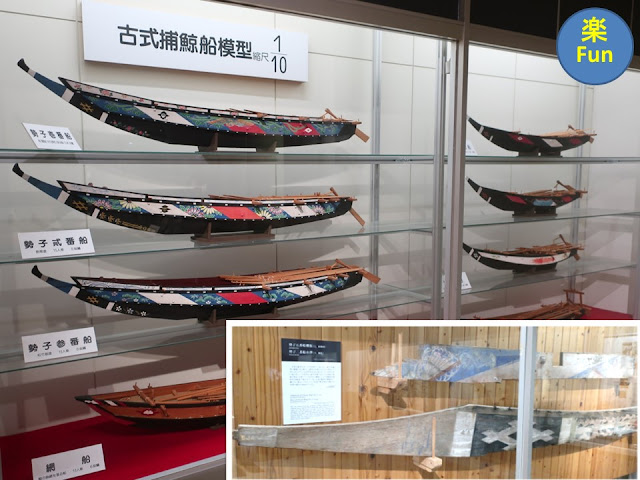Fishermen of Taiji developed to catch a whale in groups in the 17th century. It was said that the catch of a whale enriched people of seven villages; people utilized all parts of a whale including baleen and tendon. It was a major industry of Taiji. In the modern era, they used a western-style harpoon gun. In 1988, Japanese government quit catching a commercial whaling. Therefore, they only catch a small whale which comes in to their bay; but it accounts for 28% of their catch in 2012 (834 tons in total).
I would like to explain the old and
systematic whaling in which more than five hundred fishermen were engaged. I’m
sure that it was an exciting work like a festival.
17世紀に太地町の漁師が組織的な捕鯨方法を確立しました。鯨は「一頭で七郷が潤う」といわれ、人々は鯨のヒゲや筋まで余すところなく利用しました。町を挙げての一大産業でしたが、近代になると捕鯨砲を使って遠洋で行う西洋式の捕鯨になりました。そして、1988年に、日本は商業捕鯨を中止しました。今では沿岸で小型の鯨を網に追い込んだり突きとったりする小規模な捕鯨になっていますが、それでも太地の水産量834tの28%と占めています(2012年)。
本記事では、500人以上の人々が参加するダイナミックな古式捕鯨を中心に紹介します。祭りのように盛り上がる仕事だったと思います。
A small whale is keeping a letter on the post in front of the museum.
博物館の前のポストの上にも鯨がいます。
The museum is in the park which we can see a dolphin or a whale show. A small whale jumped in the show (lower right).
博物館は、太地くじら浜公園の中にあります。鯨やイルカがショーを見せてくれます。見事なジャンプ(右下)を見せてくれたのは小型の鯨です。
The model and the video show us how to catch a whale before they used a gun (until the 19th century). Soon after a watch at the top of the hill found a whale, boats departed from the port. They enclosed the whale by nets and harpooned it. Each boat had a different role. The model above shows they towed the whale to their port.
ジオラマと映像で、明治時代まで行われた太地の古式捕鯨が説明されています。高台から岸に近づく鯨を見つけ、船団が出動して網で囲い、銛で突きました。それぞれの船の役割があります。模型は、勢子船が捕らえた鯨を浜に曳行しているところです。
After enclosing a whale, a fisherman threw a light harpoon at first, then he threw a heavy and effective one. The highlight was a man rode on the whale and delt a death blow by a sword (above). I think it’s a sport more than a work. Harpoons and swords are exhibited.
網で囲んだ鯨には、まず、軽い早銛を投げ、威力が大きな角銛を投げるなど数種を投げ分けています。花形は、鯨が弱ったところで鯨に乗り、剣でとどめを刺す役(刃刺)です。仕事というか、スポーツの領域ですね。銛や剣も展示されています。
Their boats were so colorful. Models (1/10) and actual ones are exhibited. They were so flashy.
船は鮮やかに塗られています。1/10模型と実物(右下)が展示されています。何かと派手ですね。
The full-scale models of a whale and a boat are displayed at the hall. I respect fishermen because they fought against a whale with poor tools. They just had caught a whale washed up on a beach before they developed the fishing method.
博物館のホールには、鯨と勢子船の実物大模型が吊されています。よくぞ鯨に挑みました。捕鯨方法が確立されるまでは、浜に打ち上げられた鯨を、ありがたくいただいていたそうです。
They filleted and cleaned the whale at the beach in front of Asuka shrine. Those were salted and were delivered. Then, all villagers celebrated with dance. They caught ninety-five whales in a year in 1681. It brought them around four million dollars at current value.
飛鳥神社の前の浜へ持ち帰った鯨は解体され、塩漬けなどに加工され、出荷されました。そして、鯨踊り。村で祝います。1681年には95頭も捕れ、6000両という富をもたらしました。(「日本遺産 鯨とともに生きる」から)
A building of the Taiji fisheries cooperative is at the beach in front of Asuka shrine now. The current beach is a calm fishing port inside a breakwater.
絵に描かれた浜には漁協の建物があります。その後ろにあるのは、絵の左側にある飛鳥神社です。今は防波堤の内側にある静かな漁港です。
At the section named “The Last Harpooner” (The end of old whaling, and an introduction of American and Norwegian whaling), the modern whaling is explained in details.
最後の刃刺(古式捕鯨の終焉とアメリカ式捕鯨、そしてノルウェー式捕鯨の導入)。近代捕鯨方法が詳しく説明されています。
In this section, whale as creature is explained.
生物としての鯨の展示です。
When people filleted and cleaned a whale
at their beach, all villagers were strongly interested in whale, I’m sure. And
a harpooner was a hero. However, in the distant water fishing at present, I think whales are not familiar. Only visible work could create
the culture.
浜に鯨を揚げていた頃は、村人みんなが鯨に関心を持っていたし、鯨漁師は憧れの仕事だったと思います。でも、遠洋漁業になると鯨は遠い存在になってしまったのではないでしょうか。目に見える仕事は文化を生みますね。
Official website: http://www.kujirakan.jp/ (in Japanese), accessed in October, 2023
Visited in
March, 2023
Previous post (rare and famous hot-spring in the neighboring town): Boki-do cave bath (Hotel Urashima)、忘帰洞(ホテル浦島)
Next post (particular landscapes in the same prefecture):Nanki Kumano Geopark、南紀熊野ジオパーク










Comments
Post a Comment